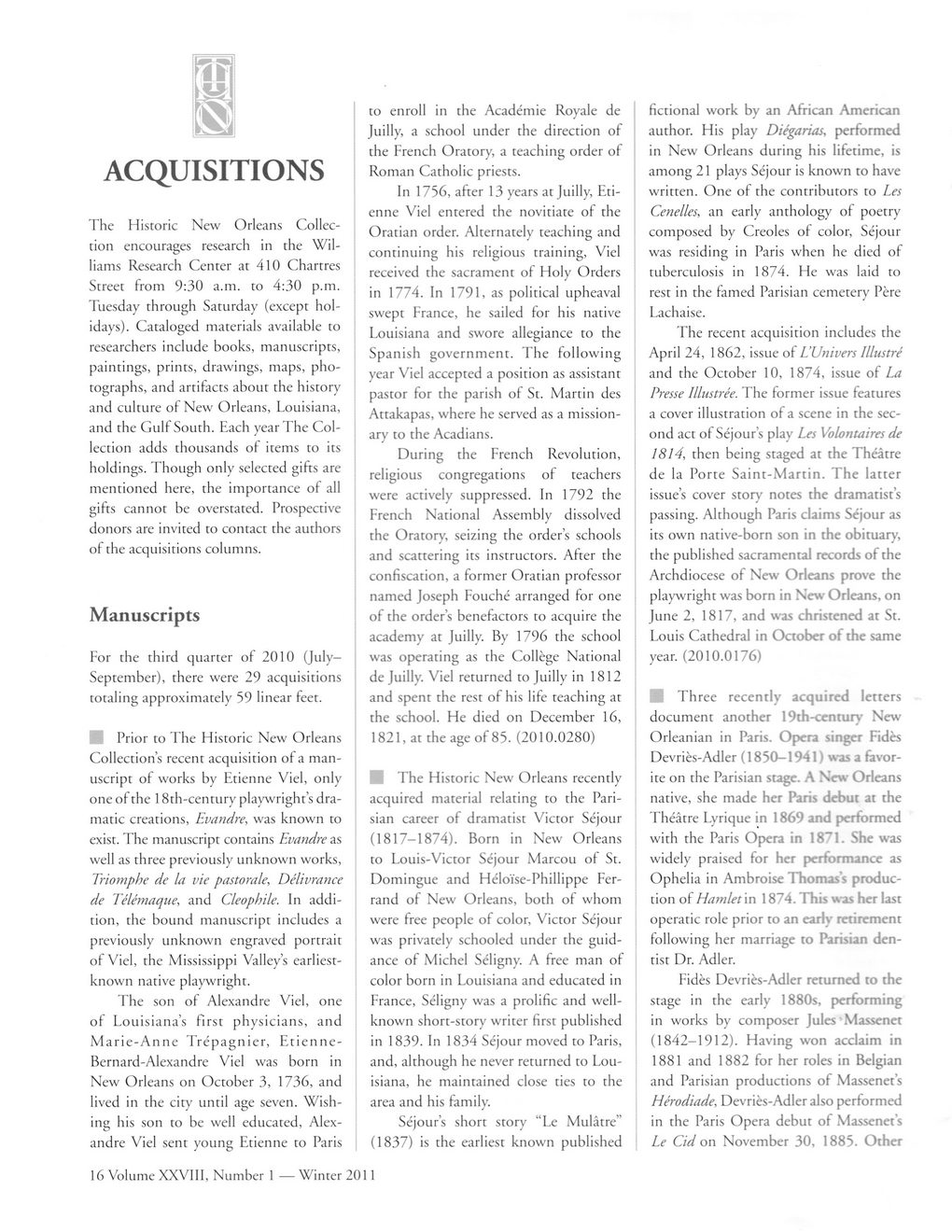This text was obtained via automated optical character recognition.
It has not been edited and may therefore contain several errors.
ACQUISITIONS The Historic New Orleans Collection encourages research in the Williams Research Center at 410 Chartres Street from 9:30 a.m. to 4:30 p.m. Tuesday through Saturday (except holidays). Cataloged materials available to researchers include books, manuscripts, paintings, prints, drawings, maps, photographs, and artifacts about the history and culture of New Orleans, Louisiana, and the Gulf South. Each year The Collection adds thousands of items to its holdings. Though only selected gifts are mentioned here, the importance of all gifts cannot be overstated. Prospective donors are invited to contact the authors of the acquisitions columns. Manuscripts For the third quarter of 2010 (July-September), there were 29 acquisitions totaling approximately 59 linear feet. I Prior to The Historic New Orleans Collection’s recent acquisition of a manuscript of works by Etienne Viel, only one of the 18th-century playwright’s dramatic creations, Evandre, was known to exist. The manuscript contains Evandre as well as three previously unknown works, Triomphe de la vie pastorale, Delivrance de Telemaque, and Cleophile. In addition, the bound manuscript includes a previously unknown engraved portrait of Viel, the Mississippi Valley’s earliest-known native playwright. The son of Alexandre Viel, one of Louisiana’s first physicians, and Marie-Anne Trepagnier, Etienne-Bernard-Alexandre Viel was born in New Orleans on October 3, 1736, and lived in the city until age seven. Wishing his son to be well educated, Alexandre Viel sent young Etienne to Paris to enroll in the Academie Royale de Juilly, a school under the direction of the French Oratory, a teaching order of Roman Catholic priests. In 1756, after 13 years at Juilly, Etienne Viel entered the novitiate of the Oratian order. Alternately teaching and continuing his religious training, Viel received the sacrament of Holy Orders in 1774. In 1791, as political upheaval swept France, he sailed for his native Louisiana and swore allegiance to the Spanish government. The following year Viel accepted a position as assistant pastor for the parish of St. Martin des Attakapas, where he served as a missionary to the Acadians. During the French Revolution, religious congregations of teachers were actively suppressed. In 1792 the French National Assembly dissolved the Oratory, seizing the order’s schools and scattering its instructors. After the confiscation, a former Oratian professor named Joseph Fouche arranged for one of the order’s benefactors to acquire the academy at Juilly. By 1796 the school was operating as the College National de Juilly. Viel returned to Juilly in 1812 and spent the rest of his life teaching at the school. He died on December 16, 1821, at the age of 85. (2010.0280) I The Historic New Orleans recently acquired material relating to the Parisian career of dramatist Victor Sejour (1817-1874). Born in New Orleans to Louis-Victor Sejour Marcou of St. Domingue and Heloise-Phillippe Fer-rand of New Orleans, both of whom were free people of color, Victor Sejour was privately schooled under the guidance of Michel Seligny. A free man of color born in Louisiana and educated in France, Seligny was a prolific and well-known short-story writer first published in 1839. In 1834 Sejour moved to Paris, and, although he never returned to Louisiana, he maintained close ties to the area and his family. Sejour’s short story “Le Mulatre” (1837) is the earliest known published fictional work by an African American author. His play Diegarias, performed in New Orleans during his lifetime, is among 21 plays Sejour is known to have written. One of the contributors to Les Cenelles, an early anthology of poetry composed by Creoles of color, Sejour was residing in Paris when he died of tuberculosis in 1874. He was laid to rest in the famed Parisian cemetery Pere Lachaise. The recent acquisition includes the April 24, 1862, issue of L’Univers Illustre and the October 10, 1874, issue of La Presse Illustree. The former issue features a cover illustration of a scene in the second act of Sejour’s play Les Volontaires de 1814, then being staged at the Theatre de la Porte Saint-Martin. The latter issue’s cover story notes the dramatists passing. Although Paris claims Sejour as its own native-born son in the obituary, the published sacramental records of the Archdiocese of New Orleans prove the playwright was born in New Orleans, on June 2, 1817, and was christened at St. Louis Cathedral in October of the same year. (2010.0176) I Three recently acquired letters document another 19th-century New Orleanian in Paris. Opera singer Fides Devries-Adler (1850-1941) was a favorite on the Parisian stage. A New Orleans native, she made her Paris debut at the Theatre Lyrique in 1869 and performed with the Paris Opera in 1871. She was widely praised for her performance as Ophelia in Ambroise Thomas’s production of Hamlet in 1874. This was her last operatic role prior to an early retirement following her marriage to Parisian dentist Dr. Adler. Fides Devries-Adler returned to the stage in the early 1880s, performing in works by composer Jules’Massenet (1842-1912). Having won acclaim in 1881 and 1882 for her roles in Belgian and Parisian productions of Massenet’s Herodiade, Devries-Adler also performed in the Paris Opera debut of Massenet’s Le Cid on November 30, 1885. Other 16 Volume XXVIII, Number 1 — Winter 2011

New Orleans Quarterly 2011 Winter (16)